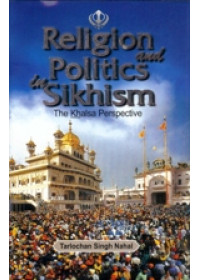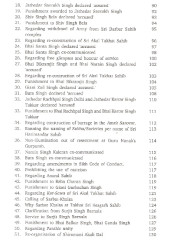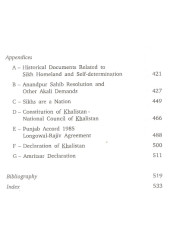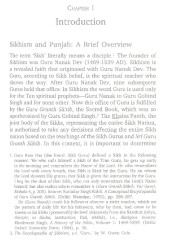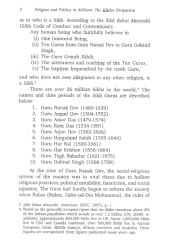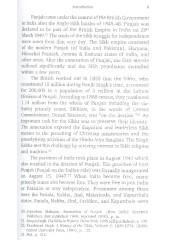Monday to Saturday - 10:00 Am to 9 PM
Now Enjoy Bulk Discounts on Books as Mentioned Below
These Discounts are in addition to the Discounts on Individual Books (Visible as Bulk Discount for Books in Cart)
Extra 10% Off If Books Purchased Exceeds Rs 3000 or 75 USD or 60 GBP or 60 Euro or 100 AUD or 100 CAD
Extra 15% Off If Books Purchased Exceeds Rs 6000 or 150 USD or 120 GBP or 120 Euro or 200 AUD or 200 CAD
Extra 20% Off If Books Purchased Exceeds Rs 15000 or 225 USD or 180 GBP or 180 Euro or 300 AUD or 300 CAD
Extra 25% Off If Books Purchased Exceeds Rs 30000 or 300 USD or 240 GBP or 240 Euro or 400 AUD or 400 CAD
Introduction To 'Religion And Politics In Sikhism - The Khalsa Perspective' By Tarlochan Singh Nahal
The very thought of "Sikh Struggle" in the modern Sikh History automatically brings to mind the infamous "Operation Blue Star" (Indian army's attack on the holiest Sikh shrines including the Golden Temple and Sri Akal Takhat Sahib) in June 1984 and the Khalistan struggle that ensued.
The scope of this book is far deeper and goes far beyond. In this monumental work, the author explains how religion and politics are intertwined in Sikhism and how the doctrine of Miri-Piri (spiritual and temporal authority) in Sikhism has shaped the Sikh struggle and political thought for centuries.
This book is intended for any student of Sikh history who wants to Know about the genuine history of the Sikh struggle which is neither tainted nor sanitized by an 'official version'. This book starts with a brief introduction to Sikhism and then provides a historical perspective of the Sikh struggle and explains the doctrine of Miri-Piri. Then it provides detailed information on the precursors of Khalistan struggle, recorded events related to that struggle, Sikh - Nirankari clash, Dharm Yudh Morcha, Operation Blue Star and its aftermath. It Provides great details of the Sikh armed struggle and gross human rights violations by the Punjab police and Indian security forces. It also provides several important historical documents related to the Sikh struggle in the form of Appendices.
This is the most comprehensive research work dealing with these topics.
About The Author Of 'Religion And Politics In Sikhism'
Dr. Tarlochan Singh Nahal (b. 1953) received an M.A. degree in English from Guru Nanak Dev University Amritsar in 1977 and Ph.D. in Political Science from Senior University International (USA) in 1999 under the supervision of Dr. Noel Q. King, Professor Emeritus, University of California, Santa Cruz, California. The topic of his Ph.D. thesis was Miri-Piri: Religion and Politics in Sikhism with Special Reference to the Sikh Struggle (1947-1997).
Dr. Nahal is a keen student of Sikh history and observer of Political developments. He has been working as a Sr. Technical Writer in the computer industry for the last 27 years. He has organized several international Sikh academic conferences in the USA in the last 15 years. He has also been actively working with the local Sikh Youth in promoting sports and healthy living.
Dr. Nahal received a siropa (Robe of Honor) at Sri Akal Takhat Sahib, the seat of Sikh spiritual and temporal authority at Amritsar, in January 2008 for his research on the Sikh history and dedication to the Khalsa Panth.
Foreword To 'Religion And Politics In Sikhism - The Khalsa Perspective' By Tarlochan Singh Nahal
In 1995, I was invited to the Sikh Gurdwara - San Jose to speak at a Miri-Piri Sikh Conference organized by the Gurdwara Committe. There were many others scholars of repute from the US and Punjab. They were all part of a delegation that came with Jathedar Manjit Singh, then Jathedar Takhat Sri Kesgarh Sahib, and acting Jathedar Sri Akal Takhat Sahib. Tarlochan Singh Nahal was one of the main organizers of this event. This is how we came to know each others.
Almost a year passed by. Then I got a call from Tralochan Singh Nahal. He expressed his desire to work on a doctorate on Sikh studies. He sought my advice and opinion. He certainly was very motivated. I invited him to my home to discuss this with me and suggested that he could write a Ph.D. thesis on the doctrine of Miri and Piri in Sikhism.
Tarlochan Singh Nahal had already received an M.A. in English from Guru Nanak Dev University and completed M.A. Part I in Punjabi from Guru Nanak Dev University with Distinction. Working as a Senior Technical Writer in the high-tech industry for many years gave him an edge both in terms of writing skills and research methodologies. I suggested that he talk to Senior University International where I was a faculty advisor. He and I talked to Prof. Hassan, the Dean of faculty. After the formal academic eavaluation, he was accepted as a candidate in the Ph.D. program in 1996. We have worked together on that theme.
Over the next almost three years, he stayed in regular cantact with me and saw me on a regular basis. During that period he visited India, Canada, England and various parts of the US. His research in the Indian Office Library in London ten years ago yielded excellent results. He came back with some fresh information that other Sikh scholars had not found until that time. He is the first schloras to find the word Khalistan in the pre-partition British files. He also dug out some rare historical documents and correspondence between the Sikh leaders (Master Tara Singh, Baldev Singh, Swaran Singh, Mangal Singh, etc.) and the British Government just before the partition of India. He personlly interviewed dozens of Sikhs in England, USA and Canada who have been involved in the Sikh struggle in one way or another. His knowledge of Sikh religion and history is superior.
Dr. Tarlochan Singh Nahal is an avid student of Sikh history amd maintains a vast personal library that consists of thousands of volumes. He received his Ph.D. in April 1999 under my supervision. The topic of his Ph.D. thesis was "MIRI AND PIRI :RELIGION AND POLITICS IN SIKHISM WITH SPECIAL REFERENCE TO THE SIKH SRTUGGLE (1947-1997)."
I believe the whole relationship of secular and sacred power is much more complicated in Sikhism than it is in Christianity. When asked about the problem of church and state, Jesus asked whether any of the bystanders has a denarius, (translated as penny in the older English versions), the question obviously had not been an honest one and Jesus felt a trick question deserved a trick answer and he gave the great saying: " Render unto Caesar that which is Caesar's and unto God that which is God's".
With the teaching of the Gospel of Mark (chapter 12, verse 14) and Genesis (chapter 2, verse 7) in his mind and in the mind of all those around him, knowing that the whole human being is made in the image of God, he added. "Render unto Caesar that which is Caesar's and unto God that which is God's". The whole Eikon, as the Greeks put it, is in the image of God. Nothing belongs to annyone else unless we consciously take that which is God's and offer it to that which is false. Dr. Tarlochan Singh Nahal defines his topic in such a way that anyone is able to understand his definition as he spells it out, "In Sikhism religion and politics (spiritual and temporal) powers are intertwined. Piri (Church) imparts moral religious direction to State while Miri (State or Temporal Authority) helps maintain law and order and ensures justice, safety , equality and welfare of citizens".
My family has a long relationship with the Sikhs. I have had opportunity to work with the Sikh soldiers in World War II where the British Indian troops inflicted the first ground defeat on the Japanese imperial forces in Burma. MIne was the first Irish family to have settled in Punjab. My great grandfather was a veterinary doctor who served in the army of Maharaja Ranjit Singh. Later, he served with a Punjabi platoon from Chaklala (now in Pakistan ) in Burma and in Europe. My father William Henry KIng was the first postmaster in the GPO and sub-divisional Officer of Telegraphs in Amritsar. Growing up in Punjab long ago, I remember I learned of Guru Nanak "Sikh Ka Guru, Mussulman Ka Pir". I have much praise for the honorable Khalsa. I am delighted that we are continuing this relationship in a spiritual and academic way.
So in this book Dr. Tarlochan Singh Nahal lays before us the teachings of the Sri Guru Granth Sahib and has shown us how the concept of power and spiritual civil life interact in Sikh thinking. They are one side completely intertwined and interinvolved but at another side they are two different powers as far apart as the power of a commander at sea and a commander on land. We have badly lacked a book on this matter and now Dr. Tarlochan Singh Nahal has made it available to us. Because of the intertwining and subtlety of the topic, we request the reader to go through carefully using his or her imagination and the best intellect.
This is both a complicated and subtle topic. We requset the reader to go back to the teaching and examples of each one of the Gurus. That is why we have to ask ourselves why Guru Arjan Dev quietly ascended onto a hot plate to achieve martyrdom whereas his son Guru Hargobind Sahib sat on the throne, bore the two swords of Miri and Piri and fought pitched battles with the forces which were responsible for the martyrdom of his father. We also need to find out as why Guru Tegh Bahadur peacefully accepted martyrdom while protecting the religion of the Hindus and why the Tenth Guru had to fight pitched battles in extreme weather conditions against the mighty Mughals armies, against all odds and lose his four sons in the battlefield. In spite of all that, he wrote Zafarnamah (Epistle of Victory) to Emperor Aurangzeb, the perpetrator of the role of terror. And last, but not least, we need to look into the role of Baba Banda Singh Bahadur who chastised the evil-doers and established the first Sikh rule only a few years after Guru Gobind Singh left for the heavenly abode.
Historically, the Sikhs have been the saviors of India. They fought for its freedom and honor and paid a very steep price. The events since June 1984 forces us to think as to why the peace-loving Sikhs were compelled to pick up weapons and fight the Indian armed forces after the army attack on TheGolden Temple and many other sacred Sikh shrines. It is most necessary for a scholar to delve deep into the topic and provide factual and accurate account of events. Dr. Tarlochan Singh Nahal has just done that. He has worked very hard in digging out new historical information of great value related to MIri and Piri and Sikh struggle.
Through that kind of study, with the help os Doctor Tarlochan Singh, we begin to see the stature of the Gurus' teachings and we will be provided with the guidence we need, both in the new, post-independent Punjab and with, for instance, living in the United States. He also explains how religion and politics influence each other in the US in spite of a wall that separates religion from politics. This enables the Sikh man or woman to be true, not only to his or her scripture and to the example of the Gurus, but also to keep the law of the land in which the Guru has called us to be citizens. I commend the book to the reader begging for their most earnest and fundamental thinking on this matter.
Table Of Contents For 'Religion And Politics In Sikhism - The Khalsa Perspective' By Tarlochan Singh Nahal
|
Contents |
||
| Foreword | ix | |
| Preface | xv | |
| Acknowledgement | xxv | |
| Transcription/Pronunciation Key for Non-English Words/Phrases | xxix | |
| Glossary | xxxii | |
| 1. | Introduction | 1 |
| 2. | Historical Perspective of the Sikh Struggle | 11 |
| 3. | Doctrine of Miri-Piri in Sikhism | 51 |
| 4. | Precursors of Khalistan Struggle | 122 |
| 5. | Recorded Events Related to Khalistan from 1947 to 1977 | 173 |
| 6. | Sikh-Nirankari Clash at Amritsar in 1978 | 184 |
| 7. | Dharam Yudh Morcha: The Religious War | 234 |
| 8. | Operation Blue Star | 251 |
| 9. | Sikh Struggle after Operation Blue Star | 328 |
| 10. | False Encounters and Death in Police Custody | 373 |
| 11. | Conclusion | 404 |
| Appendices | ||
| A. | Historical Documents Related to Sikh Homeland and Self-determination | 421 |
| B. | Anandpur Sahib Resolution and Other Akali Demands | 427 |
| C. | Sikhs are a Nation | 449 |
| D. | Constitution of Khalistan - National Council of Khalistan | 466 |
| E. | Punjab Accord 1985 Longowal-Rajiv Agreement | 488 |
| F. | Declaration of Khalistan | 500 |
| G. | Amritsar Declaration | 511 |
| Bibliography | 519 | |
| Index | 533 |
| Books | |
| Author | Tarlochan Singh Nahal |
| Pages | 568 |
| Cover | Hardbound |
| Language | English |
Religion And Politics In Sikhism - The Khalsa Perspective - Book By Tarlochan Singh Nahal
- Brand: Singh Brothers
- Product Code: SHE178
- Availability: In Stock
-
Rs.795.00
Related Products
Sikhs in The Eighteenth Century - Book By Surjit Singh Gandhi
Table of Contents For 'Sikhs in The Eighteenth Century' - Book By Surjit Singh Gandhi ..
Rs.500.00
Historical Dictionary Of Sikhism - Book By W.H. McLeod
From The Backcover Of 'Historical Dictionary Of Sikhism' By W. H. McLeod A comprehensive dict..
Rs.845.00
1984 Lessons from History - Intrigue and Conflict in Centre - Sikh Relations - Books by Harminder Kaur
Table of Contents For '1984 Lessons from History - Intrigue and Conflict in Centre - Sikh Relatio..
Rs.595.00
Banda Singh Bahadur And Sikh Sovereignty - Book By Harbans Kaur Sagoo
From the Backcover of 'Banda Singh Bahadur And Sikh Sovereignty' By Harbans Kaur Sagoo In thi..
Rs.650.00
Insights Into Sikh Religion And History - Book By G.S.Dhillon
Introduction To 'Insights Into Sikh Religion And History' By G.S.Dhillon Sikhism which arose ..
Rs.200.00
Web Of Indian Secularism Chakravyuh - Book By Gurtej Singh
From The Back Cover Of 'Web Of Indian Secularism Chakravyuh' By Gurtej Singh Chakravyuh was an im..
Rs.450.00
Tags: books on sikh historical events, books on sikh history english religion, and, politics, sikhism, the, khalsa, perspective, tarlochan, singh, nahal, punjab

